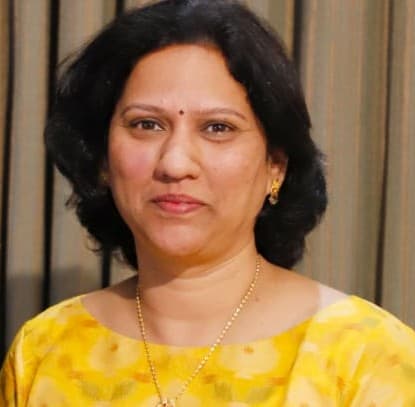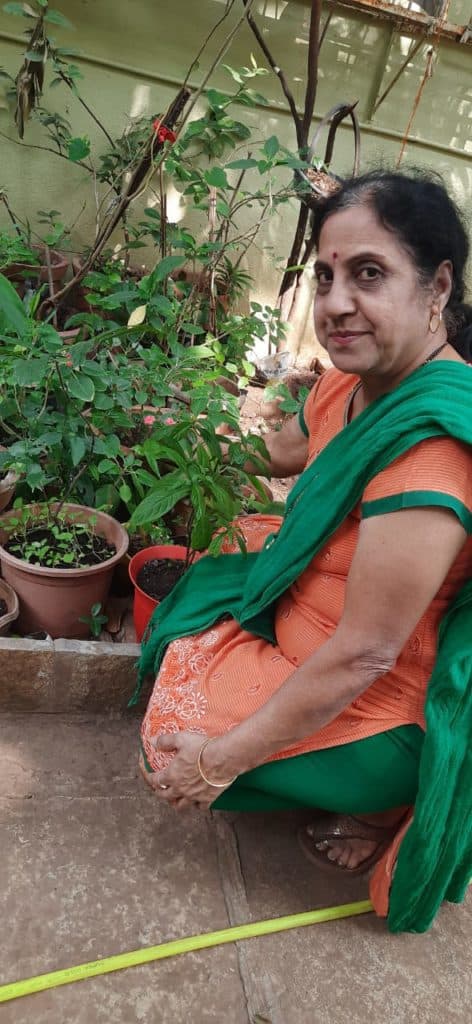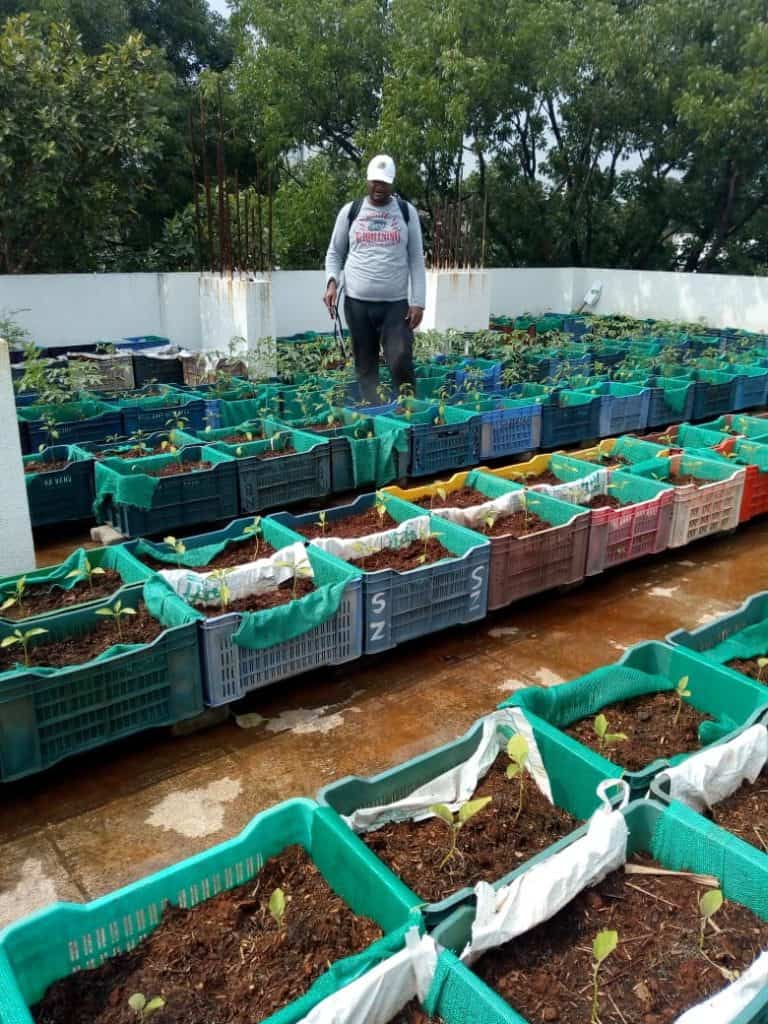A chartered accountant by profession, Snehal Gokhale takes pleasure in what used to be a hobby – watering her plants, watching the flowers bloom and the butterflies flitting from one flower to the other.
“I took up gardening to nurture an eco-system where all creatures big and small had a place of their own,” says Snehal, who has a garden in her ground floor Paud Road flat. “And we take pleasure in eating what we grow and watching the birds and butterflies and insects in a symbiotic relationship with each other”.
The nature of urban gardening is being transformed, perhaps the only positive fall out of COVID. From sanguine pleasures of tending to flowers and plants, it has now become a quest for urban gardeners to know more about the food they are eating, growing it organically and making judicious use of the waste generated in their homes.

Snehal took up organic gardening around eight years ago with other like-minded people. “We happened to learn of Digambar and Asha Ugavkar who have nurtured their terrace garden in Aundh,” said Snehal. “In Pune, we are lucky to have plenty of sunlight, good water supply and space. We thought why not grow our own food free from chemicals? Our group doesn’t buy soil for gardening. We make compost from food waste and brown leaves, and use that mud/soil. We also do not use flower pots, but use jars and mugs as planters.”
Composting and mulching
Kirti Bhave, another enthusiastic Pune gardener, has four composters that keep her terrace garden teeming with life and colour. “I started gardening when I was in college,” says Kirti. “Back then I was mainly growing flowers, especially roses. After returning to Pune in 2012, I resumed terrace gardening at my mother’s place. I am concentrating more on composting and growing vegetables and flowers.”
Kirti didn’t realise the significance of composting until she attended a lecture on the subject. “I did a course in field botany. I learnt a lot about composting from Aditi Deodhar of The Brown Leaf group, which collects dried leaves from housing societies and makes compost. I do soil-less gardening now.”

Around four years ago, Kirti made flower beds with bricks and plastic on the 1000 sq feet terrace. “I collect dried leaves from different housing societies and sandwich them with kitchen waste. I do not use any culture accelerator. I also get leftover vegetables from vendors and mulch them in the flower beds. About one third of the beds is filled with compost and thus I create my own soil. I also make the beds with sugarcane bagasse, half-done compost, cowdung. I add sterameal (a slow release fertiliser rich in calcium and phosphorus that promotes growth of plants roots) for my vegetables, fruits and tubers.”
Mulching is a process to cover the soil with dry leaves or roots stem. It prevents exposure of the soil to sun. It also prevents growing of unwanted weeds. It retains moisture and helps maintain the life of living organism in the soil. In Pune, mulching is preferred as brown leaves are abundantly available
On Kirti’s terrace you will find cabbage, cauliflower, pumpkin, zucchini, bananas and grapes, pomegranates and papaya. There are lotuses growing in a pond and tube roses, marwa, hibiscus, chafa, marigold, holyoke, mehendi, bakul and succulents serve up colours and fragrance. “I also use hardwood ash with cowdung cakes for potash,” adds Kirti. “Potash is important for circulation of water and sugar in plants and builds immunity”.
Read more: How to grow your food in your home garden: Hyderabad holds lessons
Going ayurvedic
The Somayaji’s garden in Dahanukar colony, spread over 1200 sq feet, is different in that it has spice plants, medicinal herbs, fruiting and flowering trees. “We are lucky to have a house with a garden, since we both love gardening,” says Sumati Somayaji.
The husband-wife duo are members of many gardening groups like Organic Gardening Group, The Brown Leaf and Sahavardhan, to name a few. One group is dedicated to conserving native trees. Members of Sustainable Earth Group or Deshivruksha Va Paryavaran Sanvardhan group go on ‘tree walks,’ locating local species, collecting their seeds and sowing them in by the sides of roads during the rains. Last year, the members decided to sow some seeds in Somayaji’s garden, out of which 10 saplings have survived.
“We believe in Ayurveda and these indigenous medicinal plants and herbs are a part of our heritage,” adds Sumati. “One leaf of Paanfuti consumed every morning can help dissolve kidney or gall stones. I suffered from gall bladder stones and within a month of eating these leaves I started feeling better. Stevia leaves can be a good alternative to sugar and helpful to diabetics. Haadjodi leaves can be used to treat broken bones.”
In their garden, the Somayajis have planted adulsa, shatawari, tulsi, vekhand, insulin, haadjodi, peppermint, lemon balm, basil, all vitamin and brahmi.
Becoming self-sufficient
All the people we spoke to expressed their hope to grow enough in their green patches to fulfil their needs. Snehal recently took up gardening on the terrace of her office in Narayan Peth apartment block. “Last March we decided to grow some of our kitchen requirements,” says Gokhale. “We also have poppy seeds, colassia leaves, maghai paan (betelnut leaves), spring onion, beetroot leaves for salad and fruits like lemon, papaya, kamrak. For pollination, we have kamalini and other aromatic plants”.
At her Paud Road garden, Snehal gets a good yield of green leafy vegetables. Kirti, on the other hand, says that she is not yet self-sufficient in vegetables. While the Somayajis are able to meet most of their food requirements from their plants and trees.
Suresh Bapat, another city gardener, went one step ahead and grew rice on the terrace of his bungalow in Mitramandal colony. The Bapat family had shifted here in 1973 and Suresh’s father planted fruit trees like mangoes, bananas around the house. Later Suresh and his wife, who did a course in kitchen garden, experimented and grew rice, leafy vegetables, medicinal plants etc on their 1,200 sq feet terrace.
After the rainfall in 2007, one particular pit was slushy and muddy. So Suresh asked his employee in a fabrication workshop to get him some paddy crop. They told Suresh that this was not the way to grow rice, but Suresh was determined to find it out for himself. His gamble paid off and the Bapats went on to grow 10 kg of Indrayani rice every year.
Read more: Turning fridges to agricultural fields: Mangalore school kids’ unique urban farming experiment
Sustainable practice
The benefits from urban farming can be many, besides getting fresh produce. But those wanting to get into it need to be mindful of not overusing natural resources. “We are applying principles of rainwater harvesting in our garden,” said Sunita. “We store water used for cleaning utensils, vegetables, grains and dregs of the water filter and re-use it for the plants and trees. We have been making compost and manure and that also results in less requirement of water. We have been putting aside leftover food, fruit peels, foodgrains gone bad in making manure. We have made use of coconut husks, powder them and use them for potted plants. We make brooms from coconut fronds.”
Snehal too believes in reusing home-generated waste. Food waste from her office is utilised in the terrace garden. Plus, she and her husband have been making chemical-free pesticides.
“We sprinkle gomutra, or onion water, ginger-garlic paste or neem oil+water on the plants,” said Snehal. “We ferment cooked rice in water for seven days and spray it on hibiscus plant. Banana peels soaked overnight in water can also be a good manure.”
In addition Snehal and members of Organic Gardening Group have been taking classes, webinars, holding demonstrations on composting. They also invite experts to speak on gardening innovations and giving tips to beginners.
Kirti’s advice to beginners is to be careful of overwatering, a mistake that she committed often. Kirti’s other challenge is tackling proliferation of snails in her garden. “I have used plastic sheets as layer for the brick beds and since they retain moisture, the number of snails grow overnight. The other challenge is of sunlight. Some trees, vines which require more sunlight don’t get enough of it because I have planted them in the wrong section.”
The PMC-Sahavardhan initiative
Based on the principles of community farming, especially in urban areas, Sahavardhan believes in the motto, ‘Alone I Cannot; Together We Can’. Currently, active as a WhatsApp group comprising 800 members, Sahavardhan was formed in 2019 to bring together people who were interested in growing their food organically, but had no space of their own.

In July 2019, the group had met to brainstorm over how to acquire spaces for community gardening. The meeting was also attended by the area representative of the Pune Municipal Corporation.
“She said the PMC was looking for citizen participation because they were participating in Swacch Bharat Mission and wanted to improve their rating,” said Ram Datar, CEO of Circulogix Inc, a US-based start-up now settled in Pune.
“They wanted suggestions on how to improve it. I suggested using green roof concept for the PMC buildings, where they would offer us a space for free and we would raise a garden on without any charges. They liked the idea”.
The municipal body agreed to provide water and electricity while the Sahavardhan team which then comprised 21 volunteers decided to re-use old material.
“The PMC said we could use confiscated material like crates (from roadside vendors) and cocopeat which they generate from coconut gardens,” said Ram Datar. “They also gave us the compost from the various facilities they have. We also asked them for slurry from the restaurant businesses (the waste food rots and thus becomes slurry. The PMC processes it on-site or they take it away from the city). We used all of that to create our own compost. The Sahavardhan volunteers contributed to buy seeds, saplings, shade net etc. We were given three weeks deadline and we finished the work in time for October 2, Mahatma Gandhi’s birth anniversary”.
The project named Swawalamban 1 (Self-reliance1) was executed on the terrace of the Ghole Road ward office. The Sahavardhan members planted 800 saplings but had to discontinue their work because of Covid-19. “We had a meeting with the PMC staff and gave away all the vegetables (75kg) to them. The saplings were also given away to the staff so that they could grow them in their homes,” adds Datar.
Another terrace garden was started at Baner-Aundh ward office and named Swawalamban 2. There Sahavrdhan grew around 650 plants with similar inputs. “We now have access to six other zonal offices of PMC and they have asked us to start this project in 50 other buildings,” said Datar. “We have no dearth of space or of volunteers. We had a meeting of our core group recently and we decided to resume our efforts with social distancing in mind. We also have plans to install drip irrigation system before summer”.
Sahavardhan, which developed a terrace garden at Abhinav School, near Narhe-Ambegaon, has been getting requests from other city schools and private housing societies. “But we want people to start becoming farmers,” says Datar. “In each housing society, we want at least three or four active members. We can always help them get started, but we shouldn’t be doing it for them.”
That’s the goal of Sahavardhan, to get everybody together and engage in co-operative farming.
Tips for beginners
- Start gardening during rains.
- Make your own compost, manure.
- Buy gardening tools and good quality seeds (check their expiry date).
- Learn more about your space – sunlight, its duration, water availability etc.
- Learn how to maximise your green corner. Experiment with vertical bag, hanging bag, bottle bag if you have less space. Use cartons, cups and mugs with missing handles, tubs, crates and tyres.
- Grow complementary plants like brinjals, tomatoes and chillies. If you have less sunlight streaming in, grow leafy vegetables.
- Start with kitchen staples like curry leaves, lemon grass, grafted lemons. Salad staples can also be good choice.
- Avoid planting broccoli, cauliflower when you are a greenhorn, because they are worm infested easily. Instead opt for drumsticks.
Also read:


